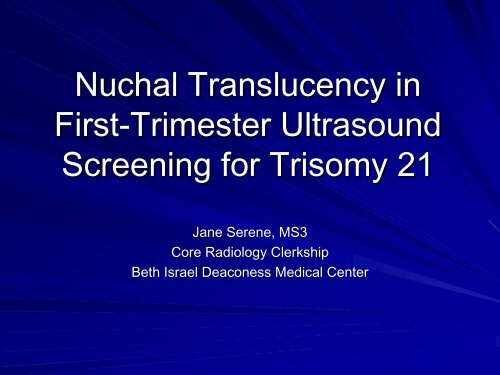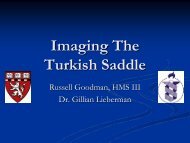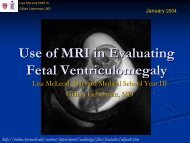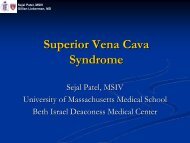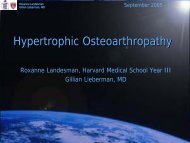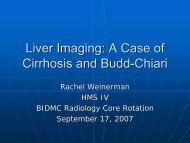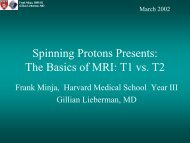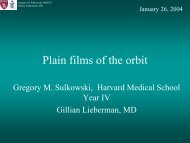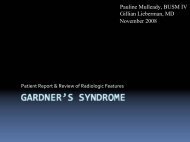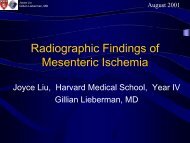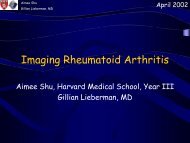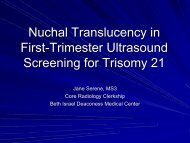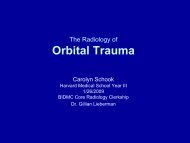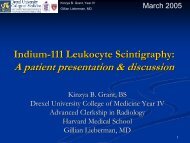Nuchal Translucency in First-Trimester Ultrasound Screening for ...
Nuchal Translucency in First-Trimester Ultrasound Screening for ...
Nuchal Translucency in First-Trimester Ultrasound Screening for ...
You also want an ePaper? Increase the reach of your titles
YUMPU automatically turns print PDFs into web optimized ePapers that Google loves.
<strong>Nuchal</strong> <strong>Translucency</strong> <strong>in</strong><br />
<strong>First</strong>-<strong>Trimester</strong> <strong>First</strong> <strong>Trimester</strong> <strong>Ultrasound</strong><br />
Screen<strong>in</strong>g <strong>for</strong> Trisomy 21<br />
Jane Serene, MS3<br />
Core Radiology Clerkship<br />
Beth Israel Deaconess Medical Center
“<strong>Nuchal</strong> translucency-based translucency based screen<strong>in</strong>g<br />
<strong>for</strong> fetal abnormalities has truly<br />
become an <strong>in</strong>dispensable aspect of<br />
contemporary obstetric practice.”<br />
(Soha Said, Cl<strong>in</strong>ical Obstetrics and Gynecology, March 2008)
Agenda<br />
Introduction to Our Patients<br />
Def<strong>in</strong>ition of <strong>Nuchal</strong> <strong>Translucency</strong> and<br />
Measurement Criteria<br />
NT <strong>in</strong> Trisomy 21 Screen<strong>in</strong>g<br />
Advantages/Limitations of NT Screen<strong>in</strong>g<br />
Differential Diagnosis of Increased NT<br />
Mechanisms of Increased NT<br />
Fetal Anomalies associated with Increased NT<br />
Follow-up Follow up on Our Patients
Two Patients With Increased Fetal Risk <strong>for</strong><br />
Trisomy 21<br />
Our <strong>First</strong> Patient<br />
41 year-old, year old, G5P2, with<br />
s<strong>in</strong>gleton pregnancy<br />
Presents <strong>for</strong> early OB<br />
ultrasound (
Def<strong>in</strong><strong>in</strong>g <strong>Nuchal</strong> <strong>Translucency</strong><br />
Fluid between sk<strong>in</strong> and<br />
soft tissue at back of fetal<br />
neck<br />
Can be seen<br />
sonographically <strong>in</strong> all first<br />
trimester fetuses<br />
Criteria <strong>for</strong> Increased NT:<br />
-NT NT > 3mm<br />
-Depends Depends on gestational<br />
age (Most accurately<br />
expressed as multiple of<br />
the median) [3]<br />
Trans-abdom<strong>in</strong>al OB U/S, sagittal view<br />
Increased NT<br />
PACS, BIDMC
Criteria <strong>for</strong> NT Measurement (1)<br />
Trans-abdom<strong>in</strong>al OB U/S, sagittal view<br />
PACS, BIDMC<br />
1.Crown-Rump 1.Crown Rump Length = 45-84mm 45 84mm (approximately 11-14wks). 11 14wks).<br />
2.Mid-sagittal 2.Mid sagittal plane with fetus <strong>in</strong> neutral position:<br />
Neck flexion decreases NT; Neck extension <strong>in</strong>creases NT.
Criteria <strong>for</strong> NT Measurement (2)<br />
Trans-abdom<strong>in</strong>al OB U/S, sagittal view<br />
PACS, BIDMC<br />
F<strong>in</strong>d<strong>in</strong>gs:<br />
1. Nasal Bone<br />
2. Ch<strong>in</strong><br />
3. Increased NT (4.2mm)<br />
3.Enlarge image: upper 2/3 of fetus.<br />
4.Identify potential false positives: non-fused non fused amnion, nuchal<br />
cord, neck extension.<br />
5.Measure maximal translucency <strong>in</strong> greatest dimension:<br />
from outer soft tissue edge to <strong>in</strong>ner nuchal membrane edge.
Inaccurate NT Measurement<br />
Trans-abdom<strong>in</strong>al OB U/S, sagittal view<br />
1. Not midl<strong>in</strong>e view: Nasal bone and ch<strong>in</strong> not visible.<br />
2. Difficult to separate fetal sk<strong>in</strong> from amnion.<br />
BIDMC-PACS
How does <strong>Nuchal</strong><br />
<strong>Translucency</strong> fit <strong>in</strong>to<br />
screen<strong>in</strong>g <strong>for</strong> Trisomy 21?
The Comb<strong>in</strong>ed Test<br />
<strong>Nuchal</strong> <strong>Translucency</strong> measurement<br />
between 11-14 11 14 weeks<br />
Maternal Serum Markers<br />
1.Free beta-hCG: beta hCG: Elevated <strong>in</strong> T21<br />
2.Pregnancy-associated 2.Pregnancy associated plasma prote<strong>in</strong> A<br />
(PAPP-A): (PAPP A): Decreased <strong>in</strong> T21
Practice Guidel<strong>in</strong>es <strong>for</strong> Trisomy 21 Screen<strong>in</strong>g<br />
ACOG 2007: All women should be offered<br />
aneuploidy screen<strong>in</strong>g be<strong>for</strong>e 20wks gestation.<br />
-us<strong>in</strong>g us<strong>in</strong>g maternal age alone to triage patients <strong>in</strong>to diagnostic test<strong>in</strong>g test<strong>in</strong>g<br />
misses 50% of T21 pregnancies that occur <strong>in</strong> women
Compar<strong>in</strong>g Screen<strong>in</strong>g Methods <strong>for</strong> T21<br />
<strong>Nuchal</strong> <strong>Translucency</strong> +<br />
Maternal Age<br />
Comb<strong>in</strong>ed Test: Age +<br />
NT + PAPP-A PAPP A + Beta- Beta<br />
hCG<br />
Full Integrated Test:<br />
Comb<strong>in</strong>ed Test + Quad<br />
Screen<br />
Serum Integrated Test:<br />
PAPP-A PAPP A + Quad<br />
Screen (No U/S)<br />
Quad Screen: serum<br />
AFP, uE3,<br />
hCG, <strong>in</strong>hib<strong>in</strong> A<br />
Gestational Age<br />
Detection<br />
Rate/Sensitivity<br />
False Positive<br />
Rate<br />
11-14 11 14 weeks 72-77% 72 77% 4.2-5% 4.2 5%<br />
11-14 11 14 weeks 85% 4.8<br />
11-14 11 14 weeks +<br />
15-18 15 18 weeks<br />
11-14 11 14 weeks +<br />
15-18 15 18 weeks<br />
85%<br />
90-95% 90 95%<br />
1%<br />
2.6-5% 2.6 5%<br />
85% 3.5%<br />
15-18 15 18 weeks 85% 6.8%<br />
*All data from FASTER (<strong>First</strong> and Second <strong>Trimester</strong> Evaluation of Risk) and SURUSS (Serum, Ur<strong>in</strong>e and <strong>Ultrasound</strong><br />
Screen<strong>in</strong>g Study) Trials.<br />
Barss VA et al. “Overview of prenatal screen<strong>in</strong>g <strong>for</strong> Down syndrome.” UpToDate 16.1.
Advantages of Screen<strong>in</strong>g with<br />
Abnormal Test<br />
<strong>First</strong>-trimester <strong>First</strong> trimester identification<br />
of patients at high-risk high risk <strong>for</strong><br />
fetal anomalies.<br />
-Allows Allows <strong>for</strong> early therapeutic<br />
abortion.<br />
-Enables Enables pre-natal pre natal plann<strong>in</strong>g<br />
<strong>for</strong> care of affected child.<br />
Triage patients <strong>for</strong> further<br />
test<strong>in</strong>g, which improves<br />
cost-effective cost effective use of<br />
resources.<br />
The Comb<strong>in</strong>ed Test<br />
Normal Test<br />
Lowers overall risk of<br />
advanced maternal age<br />
patients.<br />
-Decreases Decreases use of <strong>in</strong>vasive<br />
diagnostic procedures<br />
(CVS, amniocentesis)<br />
-Decreases Decreases procedure- procedure<br />
associated fetal loss.<br />
Reduces anxiety.
Limitations of The Comb<strong>in</strong>ed Test<br />
NT measurement is operator dependent and<br />
requires special tra<strong>in</strong><strong>in</strong>g.<br />
A significant number of patients do not get<br />
prenatal care until the 2 nd trimester.<br />
20% of obstetric patients are not be<strong>in</strong>g offered<br />
this test <strong>in</strong> spite of research demonstrat<strong>in</strong>g its<br />
efficacy.<br />
Anxiety-provok<strong>in</strong>g Anxiety provok<strong>in</strong>g when positive. If patients do<br />
not want CVS, they must wait 4 weeks <strong>for</strong><br />
amniocentesis.
You identify a neck mass<br />
dur<strong>in</strong>g first trimester<br />
ultrasound screen<strong>in</strong>g. What<br />
do you need to rule out<br />
be<strong>for</strong>e diagnos<strong>in</strong>g <strong>in</strong>creased<br />
nuchal translucency?
Differential Diagnosis: 1 st <strong>Trimester</strong> Neck Mass<br />
•Hydrops Hydrops fetalis<br />
•Cystic Cystic Hygroma<br />
•Nonfused Nonfused amnion<br />
•<strong>Nuchal</strong> <strong>Nuchal</strong> cord<br />
Less Common: Branchial<br />
cleft cyst, hemangioma,<br />
neuroblastoma.<br />
Trans-abdom<strong>in</strong>al OB U/S, axial view of fetal head<br />
Septated Cystic<br />
Hygroma<br />
Courtesy of Koeller KK, et al. “Congenital Cystic Masses of the<br />
Neck: Radiologic-Pathologic Correlation.” Radiographics,<br />
1999;19:121-146.
Potential Mechanisms <strong>for</strong><br />
Increased <strong>Nuchal</strong> <strong>Translucency</strong><br />
1.Heart stra<strong>in</strong>/failure<br />
2.Abnormal lymphatic<br />
dra<strong>in</strong>age – <strong>in</strong>creased # or<br />
size of lymphatics,<br />
irregular connection<br />
between lymphatics and<br />
ve<strong>in</strong>s, impaired fetal<br />
movement.<br />
3.Abnormal extracellular<br />
matrix<br />
Trans-abdom<strong>in</strong>al OB U/S, sagittal view<br />
PACS, BIDMC
Fetal Abnormalities Associated with<br />
Increased NT<br />
Chromosomally Abnormal<br />
Trisomy 13<br />
Trisomy 18<br />
Trisomy 21<br />
Turner’s Syndrome<br />
Triploidy<br />
Unbalanced translocations<br />
Chromosomally Normal<br />
CNS defects<br />
Diaphragmatic hernia<br />
Omphalocele<br />
Myotonic Dystrophy<br />
Esophageal Atresia<br />
Infantile PCKD<br />
Achondroplasia<br />
Fetal Anemia<br />
Metabolic defects<br />
(and others)
Increased NT and Fetal Abnormalities:<br />
An Important Caveat<br />
Increased NT is NOT a fetal anomaly <strong>in</strong> and of itself.<br />
90% of chromosomally normal fetuses with NT
Back to Our <strong>First</strong> Patient
•41 y/o G5P2<br />
•Sent <strong>for</strong> early<br />
OB ultrasound<br />
to evaluate NT<br />
secondary to<br />
Advanced<br />
Maternal Age<br />
•PAPP-A and<br />
beta-hCG<br />
levels unknown<br />
•CRL =55.2mm<br />
Patient 1: Fetal <strong>Ultrasound</strong><br />
Trans-abdom<strong>in</strong>al OB U/S, sagittal view<br />
PACS, BIDMC
Patient 1: NT Measurement on Fetal US<br />
Trans-abdom<strong>in</strong>al OB U/S, midl<strong>in</strong>e sagittal view<br />
NT = 4.1mm<br />
PACS, BIDMC
Outcome <strong>for</strong> Our <strong>First</strong> Patient:<br />
Trisomy 21<br />
F<strong>in</strong>al NT Measurement = 4.0mm<br />
Follow-up: Follow up:<br />
1.Amniocentesis at 16 weeks: 47, XX, +21<br />
2.Full Fetal Survey at 21w6d: common AV canal.<br />
3.<strong>Ultrasound</strong> at 33w2d: size
•40 y/o G3P1<br />
• Comb<strong>in</strong>ed Test<br />
Results:<br />
1.Decreased<br />
PAPP-A<br />
2.Increased<br />
hCG<br />
3.<strong>Ultrasound</strong><br />
-CRL = 63.6mm<br />
Patient 2: Fetal <strong>Ultrasound</strong><br />
Trans-abdom<strong>in</strong>al OB U/S, sagittal view<br />
PACS, BIDMC
Patient 2: NT Measurement on Fetal US<br />
Trans-abdom<strong>in</strong>al OB U/S, midl<strong>in</strong>e sagittal view<br />
NT = 2.7mm<br />
PACS, BIDMC
Outcome <strong>for</strong> Our Second Patient:<br />
Normal Fetus<br />
F<strong>in</strong>al NT Measurement= 2.6mm<br />
Follow-up: Follow up:<br />
1.Full Fetal Survey at 16w0d: No abnormalities.<br />
2.Patient decl<strong>in</strong>ed amniocentesis.<br />
3.Quad Screen at 19w1d: Lowered T21 risk<br />
4.Delivered healthy baby girl at 40w5d.
Summary<br />
<strong>Nuchal</strong> <strong>Translucency</strong>, as part of the Comb<strong>in</strong>ed Test, is an<br />
effective and accurate method of screen<strong>in</strong>g <strong>for</strong> fetal<br />
anomalies, especially Trisomy 21.<br />
Sensitive, non-<strong>in</strong>vasive non <strong>in</strong>vasive screen<strong>in</strong>g tests ensure that only<br />
those pregnancies at high-risk high risk <strong>for</strong> abnormalities undergo<br />
<strong>in</strong>vasive diagnostic procedures.<br />
Ultrasonographers must be carefully tra<strong>in</strong>ed <strong>in</strong> NT<br />
measurement.<br />
All women who receive aneuploidy screen<strong>in</strong>g should be<br />
appropriately counseled and provided with thorough follow- follow<br />
up.
Acknowledgements<br />
Dr. Hope Ricciotti<br />
Maria Levantakis<br />
Dr. Prachi Dubey<br />
Dr. Rola Shaheen<br />
Dr. Col<strong>in</strong> McCardle<br />
Dr. Gail Birch<br />
Dr. Gillian Lieberman
Resources<br />
“ACOG ACOG Practice Bullet<strong>in</strong> 77: Screen<strong>in</strong>g <strong>for</strong> Fetal Chromosomal Abnormalities.”<br />
Abnormalities.”<br />
Obstetrics and<br />
Gynecology, 109:1. Jan. 2007.<br />
Barss VA, et al. “Overview of prenatal screen<strong>in</strong>g <strong>for</strong> Down syndrome.” syndrome.”<br />
UpToDate 16.1. 16.1.<br />
(5/23/08)<br />
Benacerraf, BR. “The sonographic diagnosis of fetal aneuploidy.” UpToDate 16.1. (5/16/08)<br />
Jackson M and Rose NC. “Diagnosis and Management of Fetal <strong>Nuchal</strong> <strong>Translucency</strong>.” Sem<strong>in</strong>ars<br />
<strong>in</strong> Roentgenology, Vol XXXIII, No 4. Oct. 1998: pp333-338.<br />
pp333 338.<br />
Koeller KK, et al. “Congenital Cystic Masses of the Neck: Radiologic Radiologic-Pathologic<br />
Pathologic Correlation.”<br />
Radiographics, 1999;19:121-146.<br />
1999;19:121 146.<br />
Kurtz AB and Needleman L. “American College of Radiology Standards: Standards:<br />
Obstetrical<br />
Measurements.” Sem<strong>in</strong>ars <strong>in</strong> Roentgenology, Vol XXXIII, No 4. Oct. 1998: pp. 309-332. 309 332.<br />
Nyberg DA, et al. “<strong>First</strong>-<strong>Trimester</strong> “<strong>First</strong> <strong>Trimester</strong> Screen<strong>in</strong>g.” Radiologic Cl<strong>in</strong>ics of North America. 2006;44: 837- 837<br />
861.<br />
Reeder, MM. Gamuts <strong>in</strong> Radiology: Comprehensive List of Roentgen Differential Diagnosis. 4 th<br />
Ed. New York: Spr<strong>in</strong>ger, 2003.<br />
Said S, Malone FD. “The Use of <strong>Nuchal</strong> <strong>Translucency</strong> <strong>in</strong> Contemporary Contemporary<br />
Obstetric Practice.”<br />
Cl<strong>in</strong>ical Obstetrics and Gynecology. 51:1. March 2008.


